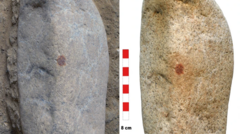Scientists excavating in Segovia, Spain, have uncovered a remarkable artifact: a pebble with a red dot resembling a human face, believed to be created by a Neanderthal who dipped his finger in pigment. This discovery, marking the earliest known instance of painted portable art by Neanderthals, raises questions about their cognitive abilities and symbolic thinking.
Ancient Discovery: Neanderthals May Have Created Art Using Pigment

Ancient Discovery: Neanderthals May Have Created Art Using Pigment
Recent findings in Spain reveal the oldest known human fingerprint, indicating that Neanderthals might have made art around 43,000 years ago.
The pebble was found in the San Lázaro rock shelter, beneath 1.5 meters of sediment that traces back to Neanderthal habitation, alongside evidence that the mark was made with abundant red ochre pigment. Researchers from the University of Complutense uncovered the stone during a five-year excavation. Co-author Prof. María de Andrés-Herrero noted that the precise placement of the dot suggests intentional artistry rather than happenstance, further emphasizing Neanderthals' capability for abstract thought.
The team's investigations revealed the fingerprint belonged to an adult male, though a lack of comparative Neanderthal references complicates definitive identification. Spanish authorities hailed the find as a significant contribution to understanding Neanderthal culture, indicating that the painted pebble not only serves as an object of beauty but also as evidence of early human creativity and social expression.
As they continue to explore this groundbreaking site, the findings will provoke further discussions around the artistic expressions and cognitive sophistication of Neanderthals. Prof. de Andrés-Herrero expressed excitement over the implications of the research, describing it as a pivotal step in understanding Neanderthal symbolic behavior.
This pebble, to some, represents more than just an artifact; it encapsulates a complex history of beings who walked the Earth long before modern humans. The potential meaning behind their actions — to create, to express, and to communicate — remains a captivating aspect of this ongoing archaeological narrative.
The team's investigations revealed the fingerprint belonged to an adult male, though a lack of comparative Neanderthal references complicates definitive identification. Spanish authorities hailed the find as a significant contribution to understanding Neanderthal culture, indicating that the painted pebble not only serves as an object of beauty but also as evidence of early human creativity and social expression.
As they continue to explore this groundbreaking site, the findings will provoke further discussions around the artistic expressions and cognitive sophistication of Neanderthals. Prof. de Andrés-Herrero expressed excitement over the implications of the research, describing it as a pivotal step in understanding Neanderthal symbolic behavior.
This pebble, to some, represents more than just an artifact; it encapsulates a complex history of beings who walked the Earth long before modern humans. The potential meaning behind their actions — to create, to express, and to communicate — remains a captivating aspect of this ongoing archaeological narrative.





















